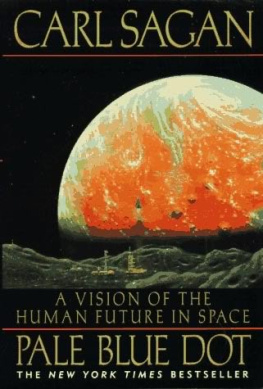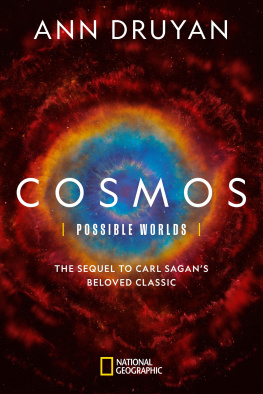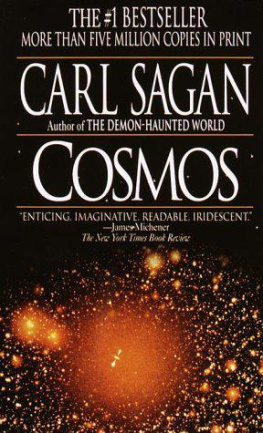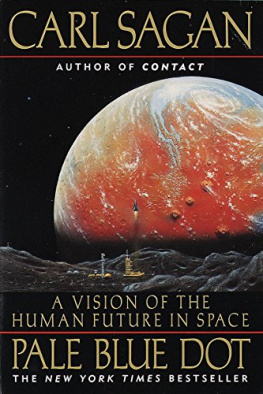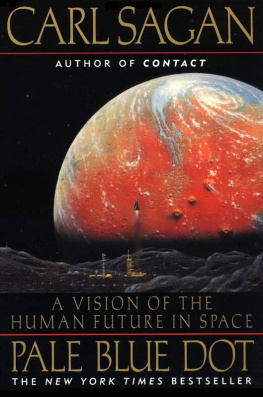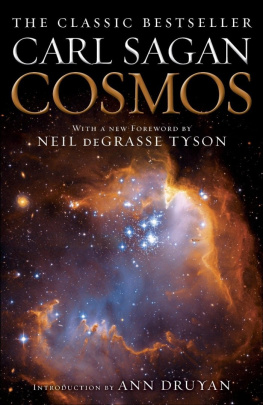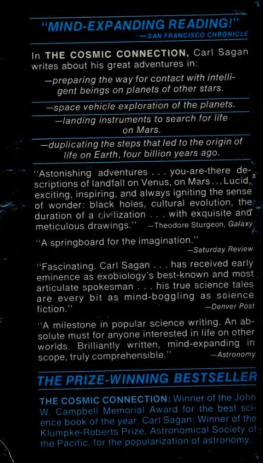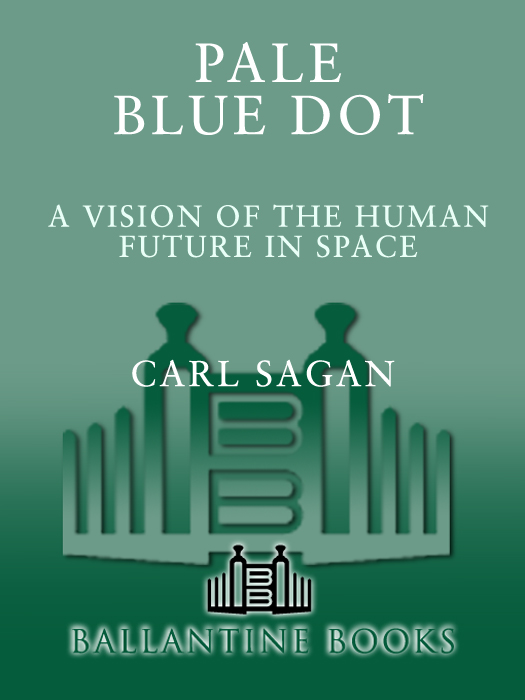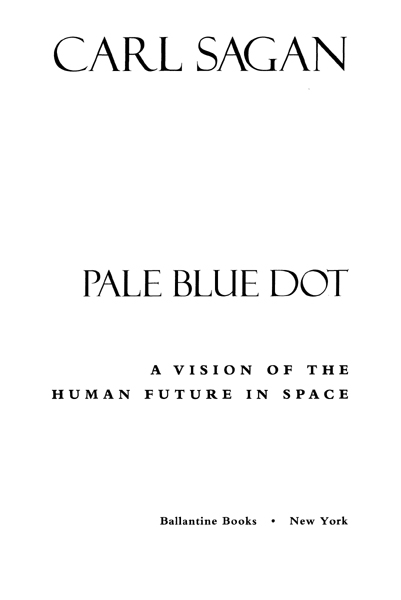DOWNRIGHT INSPIRATIONAL.
People
Elegant and appealing Jargon-free English buoyed by emotion and humor Sagans optimistic vision shines through every chapter.
Time
A practical and poetic argument for expanded space travel and exploration In typical Sagan fashion, [he] makes his case grandly and eloquently.
The San Diego Union-Tribune
Enthralling [Sagan was] a true believer in the wealth of the universe, and he may yet make apostles of us all.
Entertainment Weekly
Glowingly communicates current wonders and large issues ahead No recent book has done better at making plain the subtle nature and the fascination of scientific investigation.
Scientific American
[Pale Blue Dot] has the ambiance of a salon, where Galileo, Einstein, and others hold forth.
Air & Space
Passionate, eloquent [Sagan] fires our imagination and turns science into high drama.
Booklist
Eloquent, impassioned He builds a cogent argument that our species must venture into this vast realm and establish a space-faring civilization.
Kirkus Reviews
SOME OTHER BOOKS BY CARL SAGAN
Intelligent Life in the Universe
(with I. S. Shklovskii)
The Dragons of Eden
Brocas Brain
Cosmos
Contact: A Novel
Comet
(with Ann Druyan)
A Path Where No Man Thought:
Nuclear Winter and the End of the Arms Race
(with Richard Turco)
Shadows of Forgotten Ancestors:
A Search for Who We Are
(with Ann Druyan)
The Demon-Haunted World:
Science as a Candle in the Dark
Billions and Billions:
Thoughts on Life and Death at the Brink of the Millennium
A Ballantine Book
Published by The Random House Publishing Group
Copyright 1994 by Carl Sagan
All rights reserved under International and Pan-American Copyright Conventions. Published in the United States by Ballantine Books, an imprint of The Random House Publishing Group, a division of Random House, Inc., New York, and simultaneously in Canada by Random House of Canada Limited, Toronto.
Originally published by Random House, Inc., in 1994
Ballantine and colophon are registered trademarks of Random House, Inc.
www.ballantinebooks.com
Library of Congress Catalog Card Number: 97-94010
eISBN: 978-0-307-80101-2
v3.1_r3
FOR SAM,
another wanderer.
May your generation see
wonders undreamt.
SPACECRAFT EXPLORATION OF THE SOLAR SYSTEM
NOTABLE EARLY ACHIEVEMENTS
| SOVIET UNION/RUSSIA |
| 1957 | First artificial satellite of the Earth
(Sputnik 1) |
| 1957 | First animal in space
(Sputnik 2) |
| 1959 | First spacecraft to escape the Earths gravity
(Luna 1) |
| 1959 | First artificial planet of the Sun
(Luna 1) |
| 1959 | First spacecraft to impact another world
(Luna 2 to the Moon) |
| 1959 | First view of the far side of the moon
(Luna 3) |
| 1961 | First human in space
(Vostok 1) |
| 1961 | First human to orbit the Earth
(Vostok 1) |
| 1961 | First spacecraft to fly by other planets
(Venera 1 to Venus; |
| 1962 | Mars 1 to Mars) |
| 1963 | First woman in space
(Vostok 6) |
| 1964 | First multiperson space mission
(Voskhod 1) |
| 1965 | First space walk
(Voskhod 2) |
| 1966 | First spacecraft to enter the atmosphere of another planet
(Venera 3 to Venus) |
| 1966 | First spacecraft to orbit another world
(Luna 10 to the Moon) |
| 1966 | First successful soft landing on another world
(Luna 9 to the Moon) |
| 1970 | First robot mission to return sample from another world
(Luna 16 to the Moon) |
| 1970 | First roving vehicle on another world
(Luna 17 to the Moon) |
| 1971 | First soft landing on another planet
(Mars 3 to Mars) |
| 1972 | First scientifically successful landing on another planet
(Venera 8 to Venus) |
| 1980-1981 | First approximately year-long manned spaceflight (comparable to Mars flight time)
(Soyuz 35) |
| 1983 | First full orbital radar mapping of another planet
(Venera 15 to Venus) |
| 1985 | First balloon station deployed in the atmosphere of another planet
(Vega 1 to Venus) |
| 1986 | First close cometary encounter
(Vega 1 to Halleys Comet) |
| 1986 | First space station inhabited by rotating crews
(Mir) |
| UNITED STATES |
| 1958 | First scientific discovery in space
Van Allen radiation belt
(Explorer 1) |
| 1959 | First television images of the Earth from space
(Explorer 6) |
| 1962 | First scientific discovery in interplanetary space
direct observation of the solar wind
(Mariner 2) |
| 1962 | First scientifically successful planetary mission
(Mariner 2 to Venus) |
| 1962 | First astronomical observatory in space
(OSO-1) |
| 1968 | First manned orbit of another world
(Apollo 8 to the Moon) |
| 1969 | First landing of humans on another world
(Apollo 11 to the Moon) |
| 1969 | First samples returned to Earth from another world
(Apollo 11 to the Moon) |
| 1971 | First manned roving vehicle on another world
(Apollo 15 to the Moon) |
| 1971 | First spacecraft to orbit another planet
(Manner 9 to Mars) |
| 1974 | First dual-planet mission
(Mariner 10 to Venus and Mercury) |
| 1976 | First successful Mars landing; first spacecraft to search for life on another planet
(Viking 1) |
| 1973 | First flybys of Jupiter (Pioneer 10), |
| 1974 | Mercury (Mariner 10), |
| 1977 | Saturn (Pioneer 11), |
First spacecraft to achieve escape velocity from the Solar System
(Pioneers 10 and 11, launched in 1973 and 1974; Voyagers 1 and 2, 1977) |
| 1981 | First manned reusable spacecraft
(STS-1) |
| 1980 | First satellite to be retrieved, repaired, |
| 1984 | and redeployed in space
(Solar Maximum Mission) |
| 1985 | First distant cometary encounter
(International Cometary Explorer to Comet Giacobini-Zimmer) |
| 1986 | First flybys of Uranus (Voyager 2), |
| 1989 | Neptune (Voyager 2) |


